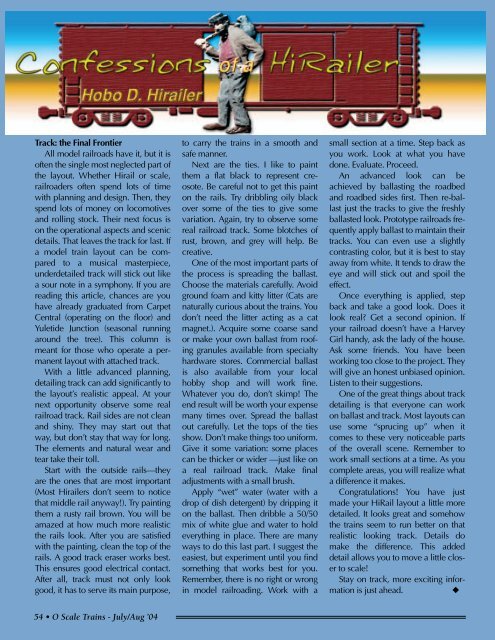Scale - O Scale Trains Magazine Online
Scale - O Scale Trains Magazine Online
Scale - O Scale Trains Magazine Online
Create successful ePaper yourself
Turn your PDF publications into a flip-book with our unique Google optimized e-Paper software.
Track: the Final FrontierAll model railroads have it, but it isoften the single most neglected part ofthe layout. Whether Hirail or scale,railroaders often spend lots of timewith planning and design. Then, theyspend lots of money on locomotivesand rolling stock. Their next focus ison the operational aspects and scenicdetails. That leaves the track for last. Ifa model train layout can be comparedto a musical masterpiece,underdetailed track will stick out likea sour note in a symphony. If you arereading this article, chances are youhave already graduated from CarpetCentral (operating on the floor) andYuletide Junction (seasonal runningaround the tree). This column ismeant for those who operate a permanentlayout with attached track.With a little advanced planning,detailing track can add significantly tothe layout’s realistic appeal. At yournext opportunity observe some realrailroad track. Rail sides are not cleanand shiny. They may start out thatway, but don’t stay that way for long.The elements and natural wear andtear take their toll.Start with the outside rails—theyare the ones that are most important(Most Hirailers don’t seem to noticethat middle rail anyway!). Try paintingthem a rusty rail brown. You will beamazed at how much more realisticthe rails look. After you are satisfiedwith the painting, clean the top of therails. A good track eraser works best.This ensures good electrical contact.After all, track must not only lookgood, it has to serve its main purpose,to carry the trains in a smooth andsafe manner.Next are the ties. I like to paintthem a flat black to represent creosote.Be careful not to get this painton the rails. Try dribbling oily blackover some of the ties to give somevariation. Again, try to observe somereal railroad track. Some blotches ofrust, brown, and grey will help. Becreative.One of the most important parts ofthe process is spreading the ballast.Choose the materials carefully. Avoidground foam and kitty litter (Cats arenaturally curious about the trains. Youdon’t need the litter acting as a catmagnet.). Acquire some coarse sandor make your own ballast from roofinggranules available from specialtyhardware stores. Commercial ballastis also available from your localhobby shop and will work fine.Whatever you do, don’t skimp! Theend result will be worth your expensemany times over. Spread the ballastout carefully. Let the tops of the tiesshow. Don’t make things too uniform.Give it some variation: some placescan be thicker or wider —just like ona real railroad track. Make finaladjustments with a small brush.Apply “wet” water (water with adrop of dish detergent) by dripping iton the ballast. Then dribble a 50/50mix of white glue and water to holdeverything in place. There are manyways to do this last part. I suggest theeasiest, but experiment until you findsomething that works best for you.Remember, there is no right or wrongin model railroading. Work with asmall section at a time. Step back asyou work. Look at what you havedone. Evaluate. Proceed.An advanced look can beachieved by ballasting the roadbedand roadbed sides first. Then re-ballastjust the tracks to give the freshlyballasted look. Prototype railroads frequentlyapply ballast to maintain theirtracks. You can even use a slightlycontrasting color, but it is best to stayaway from white. It tends to draw theeye and will stick out and spoil theeffect.Once everything is applied, stepback and take a good look. Does itlook real? Get a second opinion. Ifyour railroad doesn’t have a HarveyGirl handy, ask the lady of the house.Ask some friends. You have beenworking too close to the project. Theywill give an honest unbiased opinion.Listen to their suggestions.One of the great things about trackdetailing is that everyone can workon ballast and track. Most layouts canuse some “sprucing up” when itcomes to these very noticeable partsof the overall scene. Remember towork small sections at a time. As youcomplete areas, you will realize whata difference it makes.Congratulations! You have justmade your HiRail layout a little moredetailed. It looks great and somehowthe trains seem to run better on thatrealistic looking track. Details domake the difference. This addeddetail allows you to move a little closerto scale!Stay on track, more exciting informationis just ahead.◆54 • O <strong>Scale</strong> <strong>Trains</strong> - July/Aug ’04
















